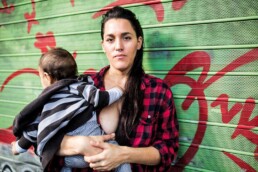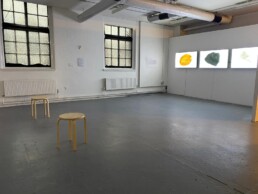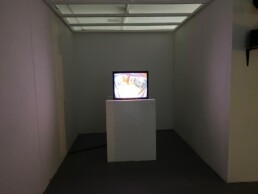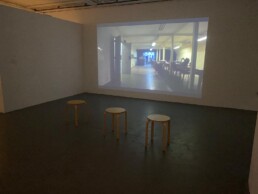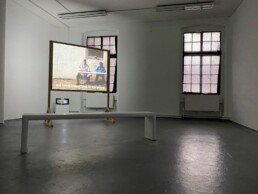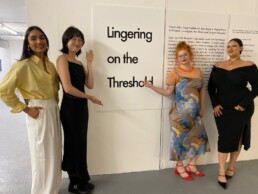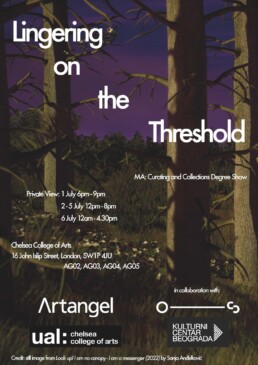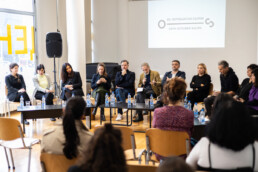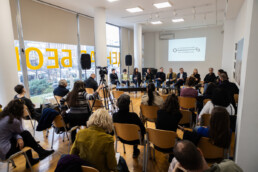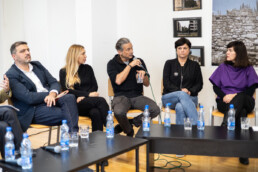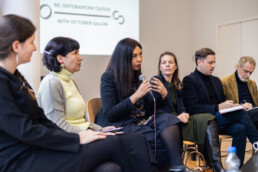THE PUPPET SHOW BY DANIELA ORTIZ ▪︎ OPENING OF THE 60th OCTOBER SALON
Луткарска представа Даниеле Ортиз, уметнице из Перуа, која ће бити представљена премијерно на тргу испред павиљона Цвијете Зузорић на дан отварања, у недељу, 20. октобра, у 13 часова, на алегоричан начин прича о неопходности борбе за слободну реч, израз, поглед на свет и живот уметности која се критички односи према економским, политичким и друштвеним императивима либералног капитализма.
————-
Данијела Ортиз (Перу, 1985) живи и ради у Урубамби. У свом раду, ствара визуелне наративе у којима се истражују концепти националности, рацијализације, друштвене класе и жанра, како би се критички разумеле структуре колонијалне, патријархалне и капиталистичке моћи. Њени новији пројекти и истраживања баве се системом контроле миграција у Европи, његовом повезаношћу са колонијализмом и правним структурама које институције стварају како би починиле насиље над расизованим заједницама у знак одмазде због њиховог отпора. Откако се вратила у Перу, уметница се у својим радовима бави интернационалном солидарношћу и бригом, борбама против екстрактивизма као и револуционарним процесима у којима устаје у одбрану приступа земљишту. Такође се у својим пројектима бавила и перуанском вишом класом и њеним израбљивачким односом према домаћим радницима. У последње време се у свом раду вратила ликовности и ручном раду, те производи уметност користећи се медијима керамике, сликања, израде лутака и колажа, као и форматима као што су књиге за децу, како би учинила отклон од евроцентричне естетике концептуалне уметности.
Поред бављења уметношћу, Данијела Ортиз је и мајка троје деце, држи предавања, радионице и учествује у различитим дискусијама и борбама против европског система за контролу миграција, империјализма, институционалног расизма и јудицијализације мајчинства.
Међу скорашњим самосталним изложбама издвајају се: Tiro al blanco, Arte Fiera 2024, Болоња (2024); Die Kinder der Kommunisten II, Kunstverein Wiesbaden, Висбаден (2023); I figli dei Comunisti I, Laveronica, Модика (2023); La Rebelión de las Raíces, àngels barcelona, Барселона (2023) и Take my blood and write on the soil, the people must know that we are being taken prisoners. An anti-colonial bow to the Cromotex Union, Theater Neumarkt, Цирих (2023). Међу скорашњим групним изложбама издвајају се: The Disobedience Archive, 60. Бијенале у Венецији (2024); True Colors, Уметничка фондација AkzoNobel у оквиру Kunstmuseum у Хагу (2024); Anti-Futurismo Cimarrón, La Virreina Centre de la Imatge, Барселона (2024); Looking a-way: Othering in/of the (semi)periphery, tranzit, Словачка (2024); A Model, Mudam Луксембург, Луксембург (2024); GUT_BRAIN 1. Destructive Desires and Other Destinies of Excess, Галерија Блеквуд, Торонто (2024) и Preludio. Intención poética, Колекција MACBA, MACBA, Барселона (2024).
OPENING OF THE 60TH OCTOBER SALON
All exhibition spaces that will be open to the public from October 20 at 1 p.m. are:
☆ galleries of the Cultural Center of Belgrade (Likovna galerija, Podroom Gallery, Artget Gallery)
☆ Pavilion in Cvetni Trg
☆ Gallery of the Faculty of Fine Arts (FLU)
☆ former club Academy
☆ Gallery of the Association of Fine Artists of Serbia (ULUS)
☆ Gallery of the Association of Fine Artists of Yugoslavia (SULUJ)
☆ Salon of the Museum of the City of Belgrade
☆ Museum of African Art
☆showcases of the French Institute
☆ public spaces in the city
ADDRESSES OF EXHIBITION SPACE AND WORKING HOURS
————————————–
OPENING PROGRAM
⫸ 13.00 • Plateau in front of the “Cvijeta Zuzorić” Art Pavilion, 1 Mali Kalemegdan
Daniela Ortiz, The root you pulled out is not a hole in my land; it is a tunnel • Puppet show
⫸ 14.00 • FLU Gallery, 53 Knez Mihailova St.
Kathrin Bὄhm and Jelena Micić, Penfold Principles meets EU Regulation 2024/1252 • Workshop/talk
Join Kathrin and Jelena for an informal conversation and work-in-progress
editing session to add to their narrative intervention in the gallery. “Extraction” and “Interdependence” are some of trigger words that emerge from their collaborative overlapping of two texts: The Penfold Principles and the EU Critical Raw Material
⫸ 16.00 • Salon of the Belgrade City Museum, 30 King Alexander Blvd
Guided tour through the exhibition • Curators: Matthieu Lelièvre and Maja Kolarić
⫸ 18.00 • Museum of African Art, 14 Andre Nikolića St.
Opening ceremony
Adrian Melis Sosa and Đejmi Hadrović, The Starving Bureaucrat • Performance
CRITICAL ISSUES OF TODAY AT THE 60TH OCTOBER SALON
Spaces for art and artists, new perspective on work and jobs at the present moment, dialogue between participants on the artistic and cultural scene, the less visible artists, social and climate changes; these are some of the topics that are present in works and performances which will be presented at this year’s edition of the October Salon.
During this year’s 60th edition of the October Salon, from October 20 to December 1, exhibitions and accompanying programs will take place, as usual, in several locations – the galleries of the Cultural Center of Belgrade, the Pavilion in Cvetni trg, the Gallery of the Faculty of Fine Arts (FLU), the former Akademija club, the Gallery of the Association of Fine Artists of Serbia (ULUS), the Gallery of the Union of Fine Artists of Yugoslavia (SULUJ), Salon of the Museum of the City of Belgrade, Museum of African Art, windows of the French Institute and public spaces in the city.
We spoke with curators Dobrila Denegri, Maja Kolaric, Ana Knezevic and Emilia Epstajn about cooperation with foreign curators and about art works which they would like to highlight within the three concepts that are the pillars of this year’s edition of the Salon.
On Friday, October 18, before the official opening of the October Salon, the artistic duo of Lucy and Jorge Orta will introduce us to the program and themes through a performance in front of the Cultural Center of Belgrade. This work should be an invitation to dialogue between artists, the city’s cultural scene and the structures that determine cultural policy at the local and state level. As Dobrila Denegri, art historian and curator, who worked on the Trace concept with Lorenzo Balbi, director of the Museum of Modern Art in Bologna – MAMbo, explains, these artists have been affirmed since the mid-90s with their engaged approach that problematizes the critical issues of today: climate change , danger of droughts, migration, and processes of social integration, coexistence and equality. “We decided to present the 47th version of their collective performative act, entitled 7×70 – Meal, as a form of a peaceful protest, with the idea that ‘sitting at the same table, sharing bread and food’ can be a way of drawing attention to some of the burning problems faced by artists and cultural workers in our country.”
Lorenzo’s concept for the Trace segment is based on the proposal to invest the entire budget of the manifestation in the purchase of a building that would be used as an exhibition space for the October Salon, which never had its own space. Such a facility would remain available for artists and art even after the event. However, the October Salon takes place, like years before, in several locations, so the concept was transformed. “Almost all the interventions that we have included in our October Salon segment have a similar message: it is necessary to create spaces where artists can create, and which can become humus for a more prosperous artistic and cultural scene. We want to illustrate that message through a series of examples, mainly actions, performances, workshops of foreign and domestic artists who deal with an endemic problem in every context affected by the processes of gentrification, market liberalization and, in general, the reduction of sensibility for the free creation of alternative art forms,” says Dobrila Denegri.
“The exhibition called Aesthetic(s) of Encounter(s), which was jointly designed and conceived by Matthieu Lelièvre and I, reexamines encounters in the form of artistic production as an essential and fundamental issue that prompted our desire to celebrate the 60th October Salon with this topic. Created after the liberation of Belgrade at the end of the Second World War, the October Salon embodies six decades of artistic encounters and illustrates the power of art to overcome political and territorial ups and downs, constantly reinventing itself alongside the emergence of new generations of artists raising the most important questions of their time. In this way, art renews itself and continues to offer a space where we meet again, learn and develop”, points out Maja Kolarić, director of the Museum of Contemporary Art in Belgrade, who collaborates with Matthieu Lelièvre, curator at the Museum of Contemporary Art in Lyon. “This edition of the October Salon, in its 60th incarnation, by its very format is an occasion for great collaboration through three artistic proposals brought by seven curators divided into three teams. This specific format, for such a renowned manifestation, seems quite unique and testifies more than ever to the importance of sharing and collaborating. Reaching out to others, exchanging and sharing is a guarantee of mutual success in dialogue and cooperation, and in this regard the Aesthetic(s) of Encounter(s), devised by Matthieu and me, becomes a method that goes beyond the field of artistic creation in an effort to leave a deeper mark within society and our everyday relationships. Asking the question of meeting in the context of an international exhibition, this year’s October Salon, is an invitation to an adventure that is essentially collective, made up of travel and exchange.”
“The works presented in the Hope is a Discipline segment of this year’s October Salon focus on the definition and our modern experience of work, on the uselessness of work, on the connection between work and art”, explains Ana Knežević, curator of the Museum of African Art who collaborates with Lina Džuverović, from the Chelsea College of Art of the University of Art in London, and Emilia Epstein, a colleague from the Museum of African Art. Ana especially emphasizes the video work The Value of Absence by Adrian Melis, which, although it was created 12 years ago, is still very relevant. He speaks of mistrust of Cuba’s socialist economic model, where low-paid employees made excuses to miss work so often that it became a regular practice that even state-owned enterprises began to tolerate. “That’s why Melis decides to pay for those excuses by giving people for the production of video work exactly as much money as their absence from work is worth,” says Ana Knežević.
Although the segment Hope is a discipline in the process of working with artists was developed around the slogan and motto of the African-American activist Mariam Kaba, as Emilia Epštajn explains, the both curators of the Museum of African Art also highlight local works such as the work of the art association Caravan from Valjevo or the work Recording of the Termite Landscape by the artistic duo doppleganger. Caravan members are inspired by the memorabilia they find in the Roma settlement of Bair, where members of Caravan create murals on the walls of musicians family houses, with the recommendations and suggestions of Bair people. Recording of a Termite Landscape is an essay in which the authors look at images of the past of miners in a socialist society, comparing them to the hidden image of mining in a capitalist society.
“Many of the artists who are presented within the ‘system’ Hope is a Discipline, speak and react for numerous ‘categorized’ individuals – socially exiled and forgotten, traumatized, or else reduced to acting on the social margins”, emphasizes Emilia Epstein. “Marie Kaba’s key distinction is between hope as an emotion and a passive state, on the one hand, and hope as a social engagement that requires space, effort and intention to develop, on the other hand. We are talking, in fact, about strategic action in institutions and through institutions and laws, about spontaneous organizing in public space, on the streets and in neighborhoods, in huts and apartments, but also about uninvited ‘insertion’ into the discourse.”
—————————————————————
Artists and participants of the 60th October Salon:
Trace
Aldo Giannotti, Alessandra Saviotti, Alfredo Jaar, Association of Fine Artists of Serbia (ULUS), Daniela Ortiz, Francesco Fonassi, Lidija Delić, Marija Šević, Nemanja Nikolić, and Nina Ivanović, Lucy + Jorge Orta, Maria Eichhorn, Ministry of Space Collective
Aesthetic(s) of Encounter(s)
Anne Imhof, Annika Kahrs, Biljana Đurđević, Damir Radović, Edi Dubien, Ivan Šuletić, Jeppe Hein, Jesper Just, Kyungah Ham, Malek Gnaoui, Małgorzata Mirga-Tas, Marina Marković, Nikola Dimitrović, Randolpho Lamonier
Hope is a Discipline
Adrian Melis Sosa, And Others: The Gendered Politics and Practices of Art Collectives, Caravan, Darinka Pop-Mitić, doplgenger, Feminist Duration Reading Group (FDRG), Jelena Savić, Kathrin Böhm and Jelena Micić, Kiluanji Kia Henda, Milica Dukić, Milica Ružičić, Mwana
The media conference will be held on Friday, October 18, at 12.00 p.m., at the Cutural Center of Belgrade Cinema Hall, and an organized tour of the exhibitions with the presence of artists and curators will be held on Saturday, October 19, at 5.00 p.m.
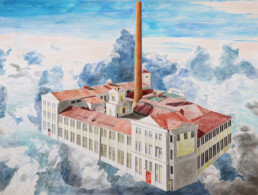
Nina Ivanović, Jugošped, 2021, akvarel na papiru, 200 x 150 cm
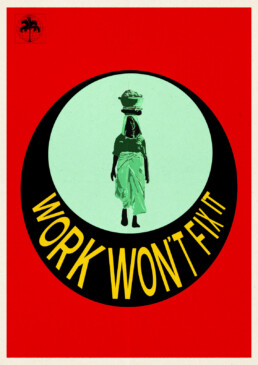
Kiluanji Kia Henda “Work wont fix it” poster
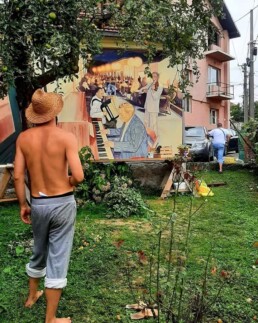
Karavan, Photo: Tijana Maric
Members of the Board of the October Salon:
Vuk Vidor, President
Gordana Goncic
Zorana Djakovic Minniti
Danica Jovovic Prodanovic
Mihael Milunovic
Founder and patron: City of Belgrade
Organized by the Cultural Center of Belgrade
Supported by the Ministry of Culture of the Republic of Serbia
Partners:
Museum of African Art
Museum of the City of Belgrade
Faculty of Fine Arts
Gallery of the Association of Fine Artists of Serbia (ULUS)
Gallery of the Union of Fine Artists of Yugoslavia (SULUJ)
Liceulice
La Biennale de Lyon
Museum of Contemporary Art, Lyon
Chelsea College of Art, University of the Arts, London
Museum of Modern Art, Bologna
Supported by:
Italian Council
British Council
Danish Arts Foundation
French Institute, Serbia
Italian Cultural Institute in Belgrade
Austrian Cultural Forum
La Boîte
Program support:
Hestia
Infomedia Group
Cvece zla
60TH OCTOBER SALON: WHAT'S LEFT?
The 60th edition of the October Salon opens on the Liberation Day of Belgrade, October 20. This fall, until December 1, the audience will encounter three different concepts created by three international curatorial teams at several locations in Belgrade.
This year’s edition of the October Salon, organized by the Cultural Center of Belgrade, takes place from October 20 to December 1. The event, which is being held for the 60th time this fall, is realized by three international curatorial teams with the slogan: “Šta ostaje?/What’s left?”
Where and what is the space for art and artists? What’s left — after we leave the exhibition spaces? What do big manifestations bring and what remains after them — … as a path, process, continuity, discontinuity, goal? What’s left after an exhibition? Then, what’s left — after all the encounters? Artists with artists, art with the public, international and local curators, spaces with artworks?
Answers and new questions will be offered during the autumn by three curatorial teams through three curatorial concepts, which is the curiosity of this year’s edition of the October Salon. Lorenzo Balbi, director of the Museum of Modern Art in Bologna — MAMbo, in collaboration with Dobrila Denegri, art historian and curator, will present a concept called Trace. Matthieu Lelièvre, curator at the Museum of Contemporary Art in Lyon, in cooperation with Maja Kolaric, director of the Museum of Contemporary Art in Belgrade, will present the concept Aesthetic(s) of Encounter(s). The third concept, Hope is a discipline, was developed by Lina Dzuverovic, Senior Lecturer and Course Leader MA Curating and Collections at the Chelsea College of Arts, the University of Arts, London, in collaboration with Emilia Epstajn and Ana Knezevic, curators at the Museum of African Art in Belgrade, and visual identity devised by Rafaela Drazic.
“60th edition is prepared and realized in the spirit and with the idea of questioning the possibility of coexistence of different conceptions, as well as curatorial and artistic positions. The Board decided to accept three proposed conceptions after curators were invited to apply with their concepts. Such a decision was motivated by the need to continue the process of reviewing the way this manifestation functions,” says Zorana Djakovic Minniti, member of the October Salon Board and program director of the Cultural Center of Belgrade “The idea of coexistence is usually understood as a method without a clear policy, so the question is whether it can fundamentally improve something within one manifestation. It is needed for all of us to think about it more actively by searching for an answer to the question from the title of the exhibition What’s left? — what remains, having in mind the additional meaning that it has in English (what’s the left today?). Since there is still no central exhibition space for the October Salon, nor was any of the existing ones in Belgrade available for use, the galleries of the Cultural Center of Belgrade will be the spaces where these three concepts will be physically closest to each other.”
The visual identity of the 60th October Salon was designed by the graphic designer and visual artist Slavimir Stojanovic Futro. “I wanted to make the visual part look like a kind of urban forest. I used symbols that are graphically very reduced, and each of them represents one of the three special curatorial exhibitions: Trace, Hope is Discipline and Aesthetic(s) of Encounter(s). When you say the names, these three concepts sound like three books you need to read. A clean, abstract graphic method resembling pictograms, where arrows determine the directions, directly illustrates the titles themselves and connects three stories. I played further by using a color palette which could almost be described as ugly, which even seems incongruous and inappropriate, it even hurts a little. But without the pain, nothing good can happen, because art is always there to ask us the most difficult questions, which is also the case with the slogan What’s left?.” Slavimir Stojanović Futro, the creator of this year’s visual identity of the October Salon, was also the author of the graphic design of the 36th October Salon, which was realized exactly 30 years ago, in 1994.
The exhibition spaces that will be open to the public from October 20 at 1 p.m. are the following: the Cultural Center of Belgrade, Pavilion in Cvetni trg, the Gallery of the Faculty of Fine Arts (FLU), the former Akademija club, the Gallery of the Association of Fine Artists of Serbia (ULUS), the Gallery of the Union of Fine Artists of Yugoslavia (SULUJ), Salon of the Museum of the City of Belgrade, Museum of African Art, windows of the French Institute and public spaces in the city.
The media conference will be held on Friday, October 18, at 12.00 p.m., and an organized tour of the exhibitions with the presence of artists and curators will be held on Saturday, October 19, at 5.00 p.m.
Members of the Board of the October Salon:
Vuk Vidor, President
Gordana Goncic
Zorana Djakovic Minniti
Danica Jovovic Prodanovic
Mihael Milunovic
Founder and patron: City of Belgrade
Organized by the Cultural Center of Belgrade
Supported by the Ministry of Culture of the Republic of Serbia
Partners:
Museum of African Art
Museum of the City of Belgrade
Faculty of Fine Arts
Gallery of the Association of Fine Artists of Serbia (ULUS)
Gallery of the Union of Fine Artists of Yugoslavia (SULUJ)
Liceulice
La Biennale de Lyon
Museum of Contemporary Art, Lyon
Chelsea College of Art, University of the Arts, London
Museum of Modern Art, Bologna
Supported by:
Italian Council
British Council
Danish Arts Foundation
French Institute, Serbia
Italian Cultural Institute in Belgrade
Austrian Cultural Forum
La Boîte
Program support:
Hestia
Infomedia Group
Cvece zla
LINGERING ON THE THRESHOLD
Francis Alÿs, Sanja Anđelković, Igor Bošnjak, Rachel Pimm & Graham
Cunnington, Ben Rivers, Gregor Schneider
An exhibition curated by MA Curating & Collections students featuring work from The Artangel Collection and The October Salon Collection.
Open July 2nd through July 5th and July 6th
Chelsea College of Arts, London, UK
Lingering on the Threshold brings together works from The Artangel collection and The October Salon collection. In these works, liminality functions as a way for artists to engage with cultural, economic, and environmental concerns by searching for new solutions outside of their current structures. In an increasingly saturated digital world, we find ourselves drawn to the realms of phantasmagoria and liminality as an escape from the noise and density of waking reality. The term “liminal” comes from the Latin word “limen,” meaning threshold. Within the exhibition, these in-between spaces take the form of desolate nuclear bunkers, museum galleries after hours, and the backseat of a taxi. Through the sphere of liminality, we discover a terrain unbound by societal expectations and prescriptions. Liminality is a state or space characterised by transformation. It is here, in this ephemeral and often enigmatic state, that our minds are liberated, allowing us to explore the depths of our existence. Lingering on the Threshold functions as a labyrinth of stories in which we invite visitors to get lost and come in contact with a dreamscape of memory, suggestion, and wonder.
Francis Alÿs’ The Nightwatch (2004) tracks a rogue fox navigating the maze of London’s National Portrait Gallery at night, seen through their CCTV system. The fox re-examines many of the same rooms, searching for entrances and exits amid a whirlwind of London’s historical ghosts. Similarly, Gregor Schenider’s Die Familie Schneider (2004) maps identical neighbouring houses, 14 and 16 Walden Street. Filmed from the perspective of the visitor and screened side-by-side, the films provide an experience of moving through the houses: faded yellow wallpaper, stained carpets, dark basements, and uncanny encounters with identical twins. Igor Bošnjak’s Hotel Balkan (2013) walks us through a desolate nuclear bunker in Bosnia, its architecture haunted by its mortal conception and the uncanny nature of human absence. Navigating through dark corridors and surrounded by textural audio reminiscent of a Geiger counter, Hotel Balkan is a liminal encounter with space and memories of the past. Ben Rivers’ Mrabet and Taxi are selections from his suite of five films, The Two Eyes Are Not Brothers (2015), partially based on Paul Bowles’ 1947 novel, A Distant Episode. In Mrabet, Rivers documents his encounter with Mohammed Mrabet, a storyteller and artist, now 88, who recounts myths and memories, blending documentary, fantasy, and fable. In Taxi, the audience is met with the haunting gaze of a fellow passenger, with directions to and from remaining unsaid and unknown, focusing instead on the interpersonal probing of sharing transitory space. This exploration of memory and liminality extends to Francis Alÿs’ Fitzroy Square (Railings) (2005), where architecture becomes a reverberating musical instrument, echoing a
sensorial memory in the city’s bones. Similarly, Sanja Anđelković’s Look up! I am no canopy – I am a messenger (2022) is a multidimensional audio/visual portal with psychological sentimentality. Guided through the animated dreamscape by an ethereal choir providing prophecies about our time, the orthodox songs lead to abstract thoughts on social issues like climate change and eco-feminism. Rachel Pimm and Graham Cunnington’s an earshare / to cassay the earthcrust (2021) is a site-specific investigation of the violent historical traces found at Orford Ness. This exploration between conservation, geology, and quantum mechanics, is centred around the concept of “earsharing,” the act of deeply listening to the Earth’s natural qualities.
Lingering on the Threshold is curated by Nis Amzee Murat, Yining Bai, Stephanie Colclough, Mengze Geng, Riccardo Greco, Maria Herrero Tejada, Yaqi Liang, Heyue Lu, Wenyan Ma, Aayushi Rajput, Qinxue Shen, Mahalia Sobers, Charmaine Wah, Wanjing Lin, Xingcheng Xu, and Lilian Zancajo-Lugo
Artist Biographies:
Francis Alÿs (1959, Antwerp, Belgium) lives and works in Mexico City. His artistic practice spans video, painting, performance, and drawing, often focusing on poetic and political interventions in urban spaces. Alÿs has participated in significant exhibitions, including the Venice Biennale (2001, 2007, 2017, 2022) and the Tate Modern, London (2010). His work addresses themes such as migration, community, and geopolitical conflict, and his interest is reflected in the social and political dynamics within urban environments.
Sanja Anđelković (1991, Novi Sad, Serbia) is an audio-visual and textual researcher-artist. Dedicated to the field of played/speculative practice, where she reconsiders her own position within the system of gender, socio-political roles and/or traumatic moments in personal history, and examines the way in which the idea of ‘home’ is changed in the historical, geographical, or environmental context. She received the New Seed Award from the Prince Claus Fund from Amsterdam (Holland, 2021). Her work has been shown at “Fabulation for Future” – Film University Babelsberg Konrad Wolf, Potsdam (Germany) at the exhibition entitled “How to be a Posthuman”. She has cooperated with anthropologist Hsiu-ju Stacy Lo on a speculative CGI feature film.
Igor Bošnjak (1981, Sarajevo, Yugoslavia) lives and works in Trebinje (Bosnia & Herzegovina) as an visual artist and filmmaker. He works on interdisciplinary research, addressing history, migrations and image-time relations as key reference in the experience of contemporary society. He is mainly working within the media fields of contemporary art: moving images, video, film, 3d animation, installation and photography. From 2006 to 2016 he was founder and curator of namaTREba project biennial. More information can be found on namatreba-project-biennial.blogspot.com. From 2009 works as a professor at Academy of Visual Arts in Trebinje, University of East Sarajevo on courses of Video, Intermedia art, Digital art. From 2019 to 2020 he was working as a visiting lecturer at the Faculty of Fine Arts Cetinje, University of Montenegro.
Graham Cunnington (1960, London, UK) lives and works in London, UK. Cunnington is primarily known as a musician and performer, also a key member of the influential industrial music group Test Dept. His work spans music, performance art, and multimedia projects. Cunnington’s performances are characterised by political intensity and social commentary, often addressing themes like resistance, labour, and industrial decline. Notable projects include collaborative performances with miners during the UK miners’; strike and large-scale industrial soundscapes, reflecting his commitment to exploring power dynamics and struggles of working-class communities; and the autobiographical solo performance ‘Pain’.
Rachel Pimm (1984, Harare, Zimbabwe) lives and works in London, UK. Pimm’s multidisciplinary practice includes performance, video, and installation, often focusing on ecological themes and the materiality of the natural world. Their work has been exhibited at institutions like the Whitechapel Gallery, London, and the Serpentine Galleries, London. Pimm’s projects often address the intersections of biology, geology, and environmental politics, emphasising the interconnection with ecosystems and the impact of human activity on the environment.
Ben Rivers (1972, Somerset, UK) lives and works in London, UK. Rivers is a filmmaker known for his experimental approach to documentary and narrative forms. His work often blurs the lines between fiction and reality, capturing remote and isolated landscapes. Rivers has exhibited at prestigious venues such as the Venice Film Festival, Locarno Film Festival, and Tate Britain. His films frequently explore themes of isolation, survival, and human interaction with nature, reflecting his fascination with the boundaries between the known and the unknown.
Gregor Schneider (1969, Rheydt, Germany) lives and works in Mönchengladbach-Rheydt. Schneider builds complete rooms consisting of floors, walls and ceilings in existing rooms. These rooms can be completely transformed into everyday life. Visitors are reminded of his disturbing depictions of living spaces to create existential confrontations. His remarkable project “Haus ur” includes the reconstruction of his parents’ house in Rheydt (1985-present). For this work he received the Golden Lion at the Venice Biennale in 2001. Schneider’s built rooms often deal with themes of fear, identity, the uncanny and question the perception of familiarity.
About the Exhibition Partners:
MA Curating and Collections at Chelsea College of Arts is a fifteen month programme centred on working in partnership with organisations across the contemporary art landscape and alongside established curators. This hands-on course equips students to handle art and design objects, learning directly from professionals across the sector. We are committed to developing ethical curatorial practices. To achieve this, we are working to embed UAL’s Principles for Climate, Social and Racial Justice into the course.
arts.ac.uk/subjects/curation-and-culture/postgraduate/ma-curating-and- collections-chelsea
Artangel produces and presents extraordinary art in unexpected places in the UK, and beyond. Appearing anywhere from empty prisons to underground vaults, daytime TV to the sky at night, Artangel produces art that takes on many different forms and appears in many different places. The Nightwatch, Fitzroy Square (Railings), Die Familie Schneider, an earshare / to cassay the earthcrust, Mrabet, and Taxi, are part of The Artangel Collection, an initiative to bring outstanding film and video works, commissioned and produced by Artangel, to galleries and museums across the UK. The Artangel Collection has been developed in partnership with Tate, is generously supported by the Esmée Fairbairn Foundation and The Foyle Foundation, and uses public funding from Arts Council England. You can explore the collection further on artangel.org.uk.
The October Salon is the biggest international contemporary art manifestation in Serbia, established by the City of Belgrade in 1960. The Salon opens its doors every other year on the 20th of October in honour of Belgrade’s Liberation Day during the Second World War. The collection comprises approximately 200 works by more than 100 artists and groups.oktobarskisalon.org
A special thank you to Frank Brown, Persilia Caton, Marina Doritis, Zorana Đaković Minniti, Adriano Digaudio, Lina Dz̆ uverović, Patricia Ellis, Matthew Evans, Ben Fitton, Karen Di Franco, Sam Hewland, Ian Monroe, Lucy Reynolds, Lynton Talbot, and Lenny Terrones-Huet
Press Contact: Lina Dzuverovic // l.dzuverovic@arts.ac.uk
Photo: Charmaine Wah
Poster Design: Riccardo Greco



THREE CURATORIAL TEAMS PRESENTED THEIR CONCEPTS FOR THE 60TH OCTOBER SALON
On Friday, December 15, a press conference was held at the ARTGET gallery of the Belgrade Cultural Centre to announce the 60th October Salon. The upcoming, jubilee edition of the October Salon will be held from October 20 to December 1, 2024, organized by the Belgrade Cultural Centre, and realized by three international curatorial teams.
Three different concepts should explore, through the exhibition and programme, how and to what extent contemporary art tries to reflect and respond to the various challenges and problems of the age we live in, but also what its internal crises say about us and our position in the present? What will the dialogue among the curatorial teams bring and how can different concepts coexist?
Zorana Đaković Minniti, Associate Director of Programmes at the Cultural Centre of Belgrade, Vuk Vidor, President of the October Salon Board, and members of the three international curatorial teams spoke at the conference. The teams include Lorenzo Balbi, the director of the Museum of Modern Art in Bologna – MAMbo, in collaboration with Dobrila Denegri, art historian and curator; Matthieu Lelievre, curator at the Museum of Contemporary Art in Lyon, in collaboration with Maja Kolarić, Director of the Museum of Contemporary Art in Belgrade and Lina Džuverović, professor at the Chelsea College of Art, University of London, in collaboration with Emilia Epštajn and Ana Knežević, curators at the Museum of African Art in Belgrade.
Zorana Đaković Minniti, Associate Director of Programmes at the Cultural Centre of Belgrade, organizer of the next edition of the October Salon, stated that KCB would coordinate the entire process and cooperation among the curatorial teams, and that the process of selecting exhibition locations is currently under way. “All three selected curatorial teams have recognized the themes and issues faced by artists and cultural workers, as well as the challenges faced by the large exhibition formats, namely, the need for more solidarity, the importance of cooperation and connecting, the lack of space for art, and the referentiality and power of the artistic work itself.”
“Following last year’s edition of the October Salon, which focused on questioning its own meaning and content and which included a large number of actors from the local art and curatorial scene, the Board considered it important that active reflection on the future of this event should be continued in the next edition as well”, said Vuk Vidor, President of the October Salon Board. “The Board considered all the themes and concepts presented by the selected curators equally important, judging that different curatorial approaches and experiences can contribute to a more active reflection on art and the creation of an international and local network of artists and institutions.”
THREE CONCEPTS FOR THE 60TH OCTOBER SALON
Lorenzo Balbi and Dobrila Denegri: Trace
What can an exhibition do to stimulate thinking about the work of artists, their future and the way to create a community of commitment? Is there anything significant that contemporary art biennials leave behind for the local community? This concept is based on the desire to create a possible new model for the upcoming edition of the October Salon, where the “trace” will continue to live and function even after two months – the official duration of the exhibition. The provocation on which this concept is based is to jointly confirm and conquer spaces for art and make them available to artists and the local Belgrade community.
Lina Džuverović, Ana Knežević and Emilia Epštajn (design: Rafaela Dražić): Hope Is a Discipline
The concept establishes hope as the central motif of the exhibition. To translate the name of the concept into practice, it involves activists and grassroots civic initiatives from different eras and different regions, and puts art in the foreground as a connective tissue in the creation of solidarity and mutually supportive networks. Artists and networks brought together within the exhibition and discursive programmes are invited to demonstrate the possibility of the parallel existence of numerous (artistic) worlds and to emphasize the potential for subtle micropolitical artistic initiatives to become real alternatives to current exploitative corporate takeovers, repressive and harmful political tendencies and environmental challenges.
Matthieu Lelievre and Maja Kolarić: The Aesthetics of Encounter
The concept will explore a wide range of themes and activities, engaging several pairs of artists who may not know each other, but – thanks to the October Salon – will be invited to put their art practices into mutual dialogue to create new spaces and new visions for art. In addition to exhibiting works, a forum for encounters and discussion will be formed, involving as many participants as possible, both in physical spaces, where the audience and professionals will explore the exhibition spaces in Belgrade, and on the Internet, in order to reach as wide an audience as possible.
